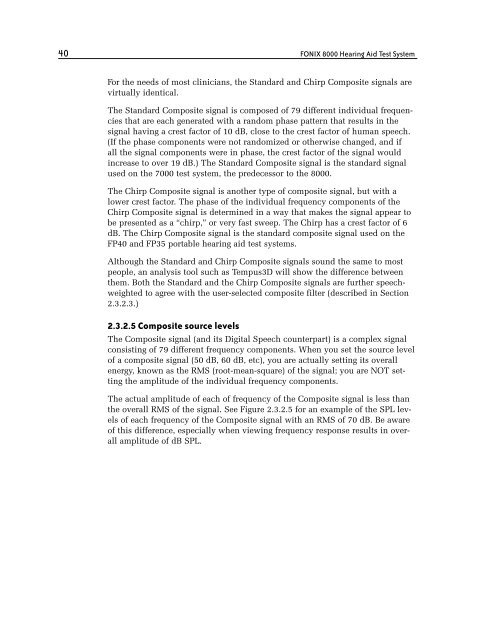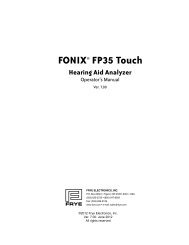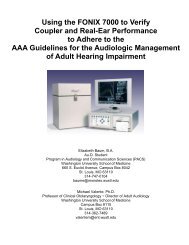FONIX® 8000 - Frye Electronics
FONIX® 8000 - Frye Electronics
FONIX® 8000 - Frye Electronics
You also want an ePaper? Increase the reach of your titles
YUMPU automatically turns print PDFs into web optimized ePapers that Google loves.
40 FONIX <strong>8000</strong> Hearing Aid Test System<br />
For the needs of most clinicians, the Standard and Chirp Composite signals are<br />
virtually identical.<br />
The Standard Composite signal is composed of 79 different individual frequencies<br />
that are each generated with a random phase pattern that results in the<br />
signal having a crest factor of 10 dB, close to the crest factor of human speech.<br />
(If the phase components were not randomized or otherwise changed, and if<br />
all the signal components were in phase, the crest factor of the signal would<br />
increase to over 19 dB.) The Standard Composite signal is the standard signal<br />
used on the 7000 test system, the predecessor to the <strong>8000</strong>.<br />
The Chirp Composite signal is another type of composite signal, but with a<br />
lower crest factor. The phase of the individual frequency components of the<br />
Chirp Composite signal is determined in a way that makes the signal appear to<br />
be presented as a “chirp,” or very fast sweep. The Chirp has a crest factor of 6<br />
dB. The Chirp Composite signal is the standard composite signal used on the<br />
FP40 and FP35 portable hearing aid test systems.<br />
Although the Standard and Chirp Composite signals sound the same to most<br />
people, an analysis tool such as Tempus3D will show the difference between<br />
them. Both the Standard and the Chirp Composite signals are further speechweighted<br />
to agree with the user-selected composite filter (described in Section<br />
2.3.2.3.)<br />
2.3.2.5 Composite source levels<br />
The Composite signal (and its Digital Speech counterpart) is a complex signal<br />
consisting of 79 different frequency components. When you set the source level<br />
of a composite signal (50 dB, 60 dB, etc), you are actually setting its overall<br />
energy, known as the RMS (root-mean-square) of the signal; you are NOT setting<br />
the amplitude of the individual frequency components.<br />
The actual amplitude of each of frequency of the Composite signal is less than<br />
the overall RMS of the signal. See Figure 2.3.2.5 for an example of the SPL levels<br />
of each frequency of the Composite signal with an RMS of 70 dB. Be aware<br />
of this difference, especially when viewing frequency response results in overall<br />
amplitude of dB SPL.
















